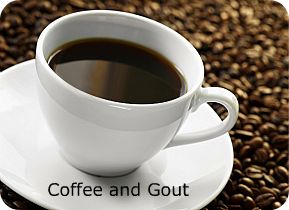[vc_row][vc_column 0=””][vc_column_text]Science shows an interesting relationship between gout and coffee . . . people who consume coffee on a regular basis have fewer gout attacks, and people who drink coffee intermittently have more gout attacks.
 This fact about gout and coffee is based on some “western medicine” studies . . . but I’ve also learned that in TCM (Traditional Chinese Medicine) coffee is considered to be horrible for the kidneys.
This fact about gout and coffee is based on some “western medicine” studies . . . but I’ve also learned that in TCM (Traditional Chinese Medicine) coffee is considered to be horrible for the kidneys.
Let’s explore this curious connection of gout and coffee a bit further. For the western medical studies focused on gout causes, understanding the chemistry between uric acid and the major compounds found in coffee explains what is going on.
Basic Uric Acid
The two major proteins that combine to form uric acid are called xanthine and hypoxanthine. The body makes an enzyme called xanthine oxidase, a substance that allows the combination to occur.
Xanthine and hypoxanthine, as well as uric acid, play important roles in healthy body functions. The body “reads” how much xanthine and hypoxanthine versus how much uric acid is circulating in the body. It has several methods to keep the levels in balance with each other.
Uric Acid Controls
- Excretion by the kidneys plays a major role in the control of uric acid metabolism. There are mechanisms the body uses to select increased excretion of xanthine and hypoxanthine or uric acid by the kidneys into urine depending on conditions needed to keep the balance.
- Inhibiting xanthine oxidase decreases the amount of xanthine and hypoxanthine that can be turned into uric acid. If the body needs more xanthine and hypoxanthine (less uric acid) it sends a message to decrease production of the enzyme xanthine oxidase. The enzyme is required for the reaction, so less enzyme results in less uric acid production.
Gout and Coffee Drinkers
54% of adult Americans admit to drinking coffee daily. Nobody knows how many people won’t admit to it. The major benefits people seek in their morning cup are the wake-me-up bitter flavor and the snap-to stimulatory effect. These qualities are primarily derived from several chemicals released from the coffee bean in the coffee making process.
- Caffeine is the primary psychoactive chemical in coffee. It is in the xanthine family of chemicals. Caffeine is a central nervous system stimulant.
- Theobromine is also called xantheose. Theobromide is also a xanthine compound with stimulatory effects. (Interestingly there is no bromine in theobromine, hence the move to rename it xantheose.)
- Theophylline is also found in coffee. This chemical has been frequently used to treat asthma for its bronchodilator action. It is also a stimulant and a member of the xanthine family.
. . .
Hi Bert,
Couldn’t wait to tell you how great I am feeling this morning. We are doing laundry today and I was able to lift the mattress to put the sheets back on the bed. Think I will be able to use the curling iron on my hair today. My arms don’t hurt when I put them over my head.
Continuation of your program is a must.
Thanks for your help!!!!
Norene
. . .
More Material, More Products
When an excess of xanthine and hypoxanthine become available, they are converted by xanthine oxidase into uric acid. Blood levels of uric acid increase. The increased uric acid can trigger increased gouty attacks. It is why we gout guys are interested in the curious connection with gout and coffee – to try to lower the amount of uric acid in our blood in the first place and prevent gout attacks.
This increased uric acid levels can occur, for example, when a lot of protein becomes available from cell death in chemotherapy or trauma. They can also occur from the occasional consumption of several cups of coffee, because the xanthines in the coffee supply the building blocks to make more uric acid.
Controls Kick In
If the amount of xanthine and hypoxanthine remain elevated, the body reads that and activates control systems to correct course and preserve the balance. Continual exposure to increased xanthines will stimulate the body to decrease xanthine oxidase production, to slow the uric acid production. At the same time, the body will increase excretion so uric acid levels in the bloodstream drop.
Scientific Study
Several large studies about gout and coffee in both men and women have consistently shown that drinking four cups of coffee daily significantly decreases the frequency of gout attacks. Studies have also demonstrated that occasional coffee drinking can initiate a gouty flare. Now we begin to understand how both reports are valid.
The regular consumption of coffee provides enough “uric acid building blocks” consistently over time to initiate the feedback loop that inhibits production and increases excretion of uric acid. However, the occasional ingestion of coffee provides enough “uric acid building blocks” to increase uric acid levels resulting in attacks, without being consistent enough to allow the feedback mechanism to occur.
It’s Not All About the Caffeine
Decaffeinated coffee was shown to have similar, but not as pronounced effects as caffeinated coffee . . . implicating the role of other xanthines not removed in the decaffeination process.
So when it comes to gout and coffee, if you are lucky enough to be one of the 4% of adult Americans with gout and you enjoy coffee, enjoy it regularly! Science shows trying to limit consumption to intermittent use will cause more painful episodes than enjoying coffee every day.
☆ Follow these links to see the studies
1) https://www.ncbi.nlm.nih.gov/pubmed/17530645
Coffee Consumption and Risk of Incident Gout in Men: A Prospective Study.
Choi HK, Willett W, Curhan G.
2) https://www.ncbi.nlm.nih.gov/pubmed/20739424
Coffee Consumption and Risk of Incident Gout in Women: the Nurses’ Health Study
Hyon K. Choi and Gary Curhan
3) https://www.ncbi.nlm.nih.gov/pmc/articles/PMC2925214/pdf/JNUME2010-930757.pdf
The Relation of Coffee Consumption to Serum Uric Acid in Japanese Men and Women Aged 49-76 Years
Pham NM, Yoshida D, Morita M, Yin G, Toyomura K, Ohnaka K, Takayanagi R, Kono S.
4) https://rheumatology.oxfordjournals.org/content/48/suppl_2/ii2.full.pdf+html
New Insights into the Epidemiology of Gout
Doherty M.
5) https://onlinelibrary.wiley.com/doi/10.1002/art.22762/pdf
Coffee, Tea, and Caffeine Consumption and Serum Uric Acid Level: The Third National Health and Nutrition Examination Survey
Choi HK, Curhan G.
SHARE THE LOVE!
☆ ☆ ☆
[/vc_column_text][/vc_column][/vc_row]

